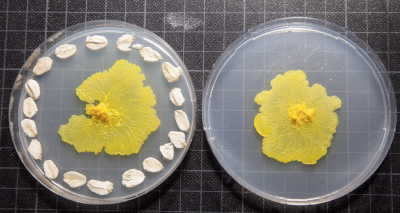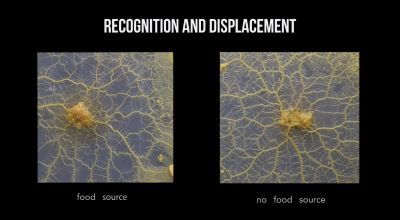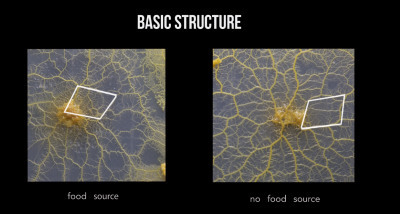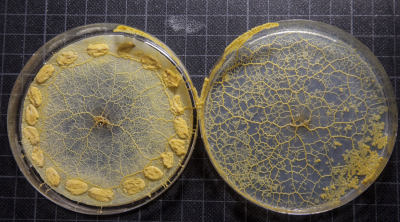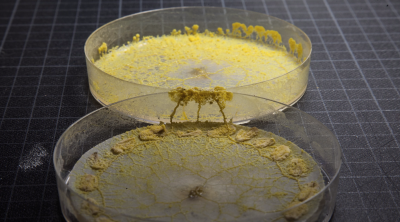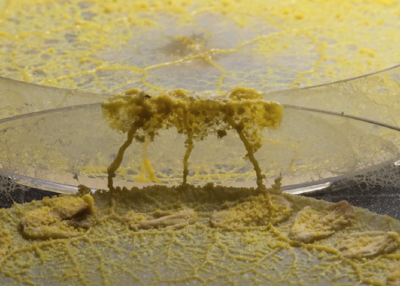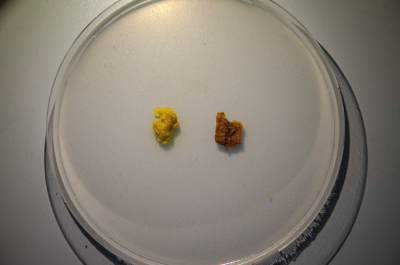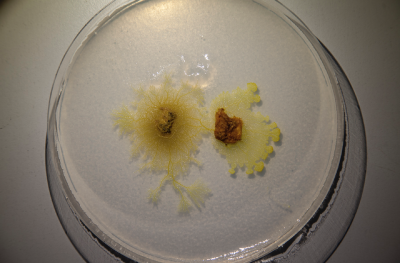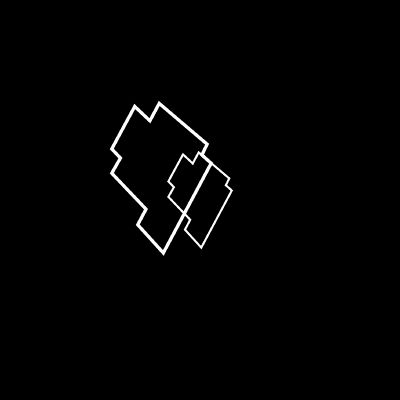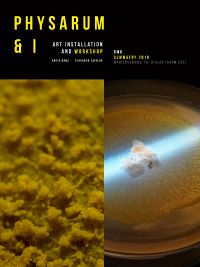Writing system for Non-Human species
A project by Fernanda Caicedo
I propose a cooperative work between two organisms - Human and Physarum polycephalum - with the purpose of building a metaphor about coexistence, social skills and proximity of behavior between two beings of opposite natures but with similar social capacities.
While there is life there will be interaction and within it there will be communication and language.
Two species, completely different from each other, collaborating together and creating a "Survival/Language" action.
Research organism
Known as the "many-headed slime" is a protist organism that lives in dark and humid places and outdoors feeds on bacteria and fungi.
Physarum polycephalum conceive the essence of improvisation for survival. It spreads, seeks for food and in every steep recognise it self with the intention of prevail. Physarum is a millions of nuclei organism, all sharing a cell wall, all operating as a single entity. The particularly way that Physarum grows also respond to a repetitive call-response pattern. They go two steeps forward and one backwards, then two forwards and one backwards and so on... They talk to each order und response, then grow...
Writing system for Non-Human species
In the history of the world, the phenomenon of writing arises when the spoken form reaches such prestige that it needs to take a physical form. Its function is the perpetuity of a message over time. A writing system is a type of symbolic system, used to express elements or expressible statements. All writing systems known in the world, have been and are developed by humans as from their needs. But what happens if human facilitates this system to other species?
According to science, there's no written, or carved symbols or anything that any non-human species has developed as a tool for communication. But, animals have a number of in-born qualities they use to signal their feelings, but these are not like the formed words we see in the human language. Countless species like bears, dogs, many insects, snakes, and cats do use chemical markings and pheromones for certain purposes. Some animals leave detailed messages for members of their own (and in some cases other) species by marking an object or the ground with a bodily excretion.
There has been scientific intentions to teach animals the human lenguaje. One of the most contested examples is Nim Chimpsky, a chimpanzee named after noted linguist Noam Chomsky, who was taught over 100 signs in sign language in the '70s. Turning hand gestures into meaning certainly displays arbitrariness. But Herbert Terrace, the psychology that led the study doubted that Nim had really learned a language. He noted that Nim very rarely signed spontaneously; instead, he would react to signs his teacher was making.
Bacteria for example communicates thought chemicals, they expel one molecule in order to express some need to the group. They need communication because they need to carry on tasks that are impossible to do by just one individual, so as humans they express desires so they can achieve goals.
The way Bacteria communicates reveals how cells (the building blocks of complex life) first came together. Molecular biologists believe that this way of proceeding from Bacteria reveals that they invented the way that groups of organisms or cells work together to do things cooperatively.
But what about writing lenguaje? What happens if human facilitates this system to other species, or some king of symbolic system? How does it look, how would that work?
Conclusion
Like so much other things in the natural world, human lenguaje evolved, didn't just arises.
It has been proved that there is a way of interaction between non-human species that allow them to reach goals, feed, pair or survived either through sounds, waves, chemical reactions or bodily excretion. But not any species aside from Humans had developed a symbolic language capable of prevail and transform. Physarum, unlike Human, its a primitive organism, but nevertheless it performs in such an organized and clever way on searching for the food with the bests nutrients. That's how Physarum manages to survive.
Process
First I need a strong and healthy Slime mold to start with. It is necessary to keep growing Physarum using the usual method (Agar+Oat flakes) so that samples of Physarum are always available for developing the experiment.
<galelry> File:2cultivating_physarum2.jpg </gallery>
Experiments
I developed some experiments for Physarum whose main axis is the action of survival from the human point of view. These experiments would allow me to understand the social nature of the organism, compare realities, forms of behavior and our proximity as species. This is the method I found wich would allow me to develop basic symbols of lenguaje.
Food versus no Food challenge
Experiment 1
I place some healthy Physarum on two petri dishes. One with enough food source and the other one without any.
After making Time Lapse recordings of the behaviour I got to recognise some interesting aspects¡
ASPECT Nr. 1
Recognition and displacement. In both cases Physarum creates a basic structure of movement. With or without Food source, Physarum expands, recognise and search in the same way:
Physarum creates a pattern while it expands. This this kind of inaccurate parallelogram allows Physarum to interact in a branched way.
I interpreted it as the symbol of COMUNICATION
ASPECT Nr.2
While expanding in search of food, Physarum was able to recognize that in the vicinity there was a group of cells with difficulties in finding food. I observed that Physarum was regrouping side to side and sensing this problem, so I brought the dishes to each other and observed how Physarum creates a Bridge in order to share nutrients and survive.
This action is interpreted as the symbol of ASSOCIATION
Live versus decease
Experiment 2
I placed some dried Physarum (wich represents a state of inactivity. In Humans represents loss of life. In the nature of Physarum the biological functions stoppt until the environment is suitable for existence) next to some healthy Physarum and record the behaviour on Time lapse.
The experiment shows how Physarum shares capacities with the ¨non living¨ cells and in this way conforms a unite front in search for food sources.
I interpreted this action as the symbol of PREVAIL
Physarum & I
A project by Antje Danz & Fernanda Caicedo
Summaery 2019
The Goal of our work is to make people curious about nature and the meanings of intelligence and creativity in a playful way. We strongly believe in the importance of didactic learning. We want to give people the possibility to experience in a close and fun relationship Bioart and the interaction with organisms. They will be able to recognize and appreciate the capabilities of micro organisms, in our case represented by the Slime Mould "Physarum Polycephalum" and change their points of view about nature and life itself by exploring the collaborations between organisms of different species (Human/Protist).
Workshop
File:EXPERIMENTOS DESCRIPCION.pdf
Visitors of the installation are invited to collaborate with the single celled social organism Physarum Polycephalum. In a small workshop set up they learn how to cultivate it, how to feed it, how to get creatively in contact and interaction with it and what they can learn from it.
Part of the single celled organism is shared with the audience as well as some easy to use Experimental Kits to collect information about the new habitat of the organism outside of the lab and its interaction especially with kids and people from a non scientific or artistic context as well as any other interested.
In the end Physarum it is fused back together into one big organism to see how it shares the outside of the lab experience among the parts.
Visitors will obtain instructions on how to document the interaction with their cell phone by using Applications such as FrameLapse or by using their camera software. They will also have the task of uploading their videos or screenshots on social networks using hashtags such as:
.#PhysarumAndMe #PhysarumIsAWriter #SummaeryBiolabExperiment
Event gallery
Maze Experiment - First try
We thought of how to do the experiment as easy as possible. First we prepared a normal agar plate with a 2 % agar solution and then In then an agar salt solution:
- 100 ml water
- 1 g agar
- 350 g sodium
Heated up everything till it boiled and then we "painted" the maze with the salt solution on the normal agar plate. We placed to flakes at the start of the maze and at the finish and set up a time lapse to see what happened. We took a picture every 8 minutes and checked after 5 days. As it has been quite hot after 3 days the plate dried out and Physarum as well. The salt speeded up the process. See the result in the video below.
Maze Experiment - second try
We want to improve the maze experiment so we started a second try. Normal agar plate was prepared again and also one full plate with the agar salt recipe. This time we printed a maze and cut out a stencil with coloured card board and put it in the liquid agar salt solution and let it sit till it cooled. We cut the maze out again and placed it in the petri dish with the 2 % water agar. We also painted a bit of the salty agar in areas we we don't want the organism to go. We placed oats at the end of the maze and the organism at the start. Time lapse is set.


